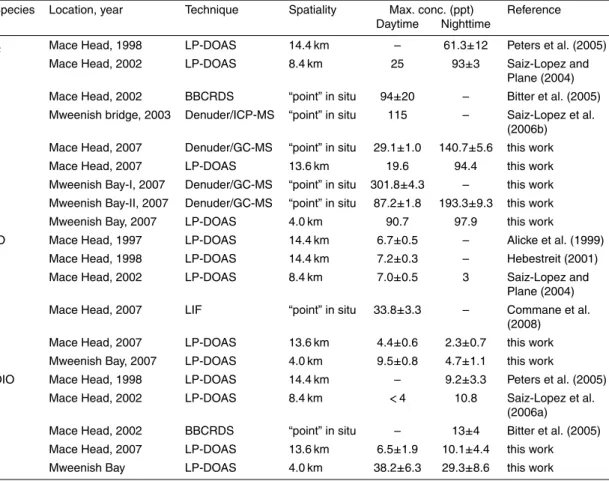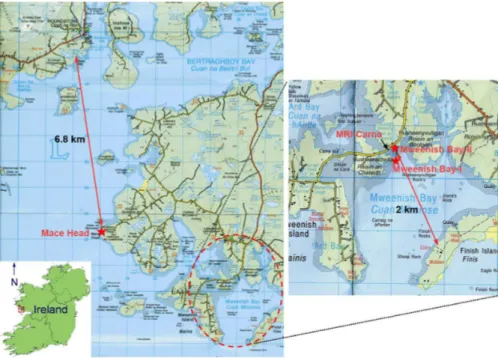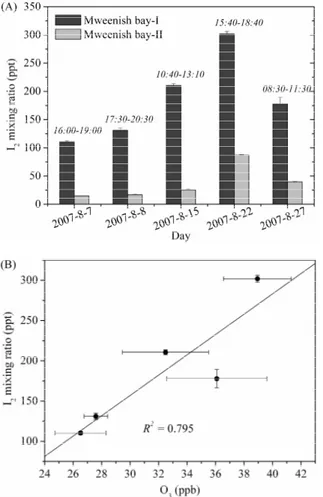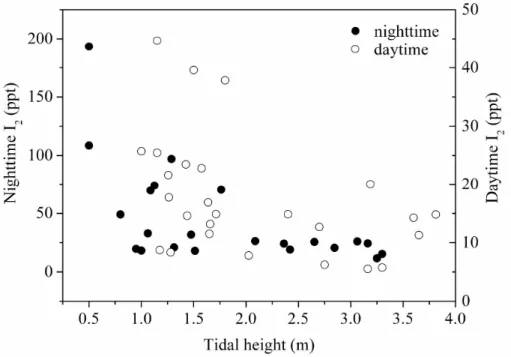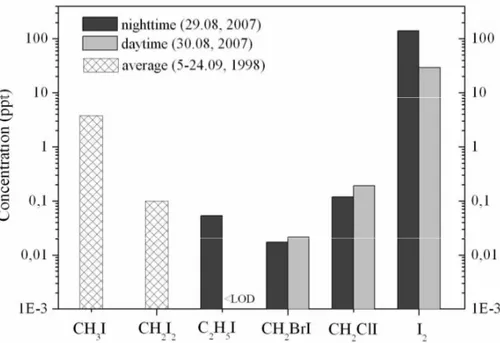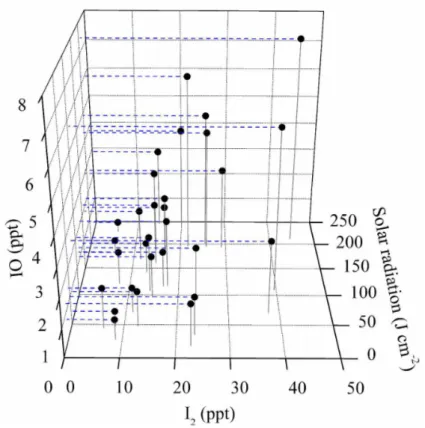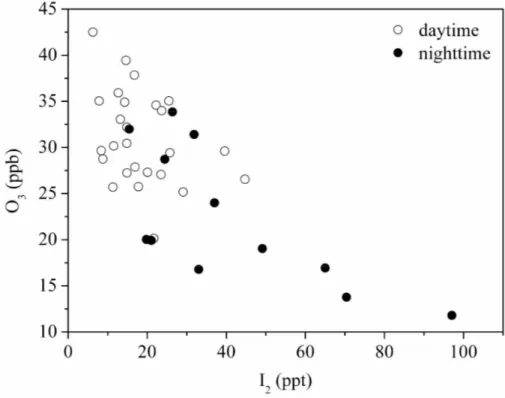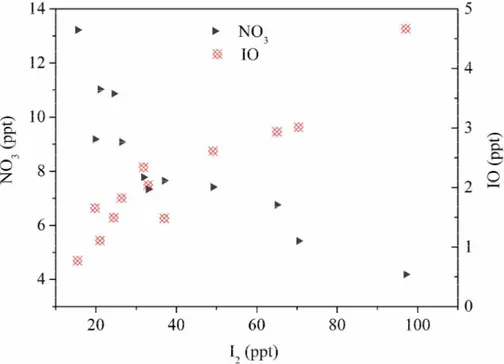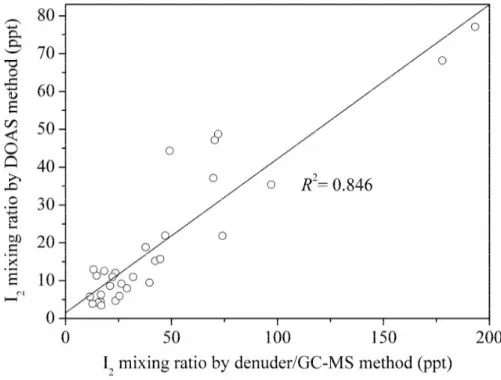ACPD
10, 361–390, 2010In situ measurements of molecular iodine in the marine boundary
layer
R. J. Huang et al.
Title Page
Abstract Introduction
Conclusions References
Tables Figures
◭ ◮
◭ ◮
Back Close
Full Screen / Esc
Printer-friendly Version
Interactive Discussion Atmos. Chem. Phys. Discuss., 10, 361–390, 2010
www.atmos-chem-phys-discuss.net/10/361/2010/ © Author(s) 2010. This work is distributed under the Creative Commons Attribution 3.0 License.
Atmospheric Chemistry and Physics Discussions
This discussion paper is/has been under review for the journal Atmospheric Chemistry and Physics (ACP). Please refer to the corresponding final paper in ACP if available.
In situ measurements of molecular iodine
in the marine boundary layer: the link to
macroalgae and the implications for O
3
,
IO, OIO and NO
x
R.-J. Huang1, K. Seitz2, J. Buxmann2, D. Poehler2, K. E. Hornsby3, L. J. Carpenter3, U. Platt2, and T. Hoffmann1
1
Institute for Inorganic and Analytical Chemistry, Johannes Gutenberg-University of Mainz, Duesbergweg 10–14, 55128 Mainz, Germany
2
Institute for Environmental Physics, University of Heidelberg, Im Neuenheimer Feld 229, 69120 Heidelberg, Germany
3
Department of Chemistry, University of York, Heslington, York YO10 5DD, UK
Received: 9 November 2009 – Accepted: 14 November 2009 – Published: 8 January 2010
Correspondence to: T. Hoffmann (hoffmant@uni-mainz.de)
ACPD
10, 361–390, 2010In situ measurements of molecular iodine in the marine boundary
layer
R. J. Huang et al.
Title Page
Abstract Introduction
Conclusions References
Tables Figures
◭ ◮
◭ ◮
Back Close
Full Screen / Esc
Printer-friendly Version
Interactive Discussion
Abstract
“Single-point” in situ measurements of molecular iodine (I2) were carried out in the
coastal marine boundary layer (MBL) using diffusion denuders in combination with a gas chromatography-mass spectrometry (GC-MS) method. Comparison measure-ments were taken at Mace Head and Mweenish Bay, on the West Coast of Ireland.
5
The observed mixing ratios of I2at Mweenish Bay are much higher than that at Mace
Head, indicating the emissions of I2are correlated with the local algal biomass density and algae species. The concentration levels of I2were found to correlate inversely with
tidal height and correlate positively with the concentration levels of O3in the
surround-ing air. However, the released I2can also lead to O3destruction via the reaction of O3
10
with iodine atoms that are formed by the photolysis of I2during the day and via the reac-tion of I2with NOxat night. IO and OIO were measured by long-path differential optical
absorption spectroscopy (LP-DOAS). The results show that the concentrations of both daytime and nighttime IO are correlated with the mixing ratios of I2. OIO was observed not only during the day but also, for the first time at both Mace Head and Mweenish
15
Bay, at night. In addition, I2was measured simultaneously by the LP-DOAS technique
and compared with the “single-point” in situ measurement. The results suggest that the local algae sources dominate the inorganic iodine chemistry at Mace Head and Mweenish Bay.
1 Introduction
20
The role of iodine chemistry in ozone depletion events and marine aerosol formation has received considerable attention in the past few years (Saiz-Lopez et al., 2007; Read et al., 2008; O’Dowd et al., 2002; Vogt et al., 1999). The precusors for these iodine-related atmospheric processes have been proposed, from early studies, to be iodocarbons such as CH3I, CH2I2, CH2CII, CH2BrI, C2H5I, C3H7I, or C4H9I (Carpen-25
ACPD
10, 361–390, 2010In situ measurements of molecular iodine in the marine boundary
layer
R. J. Huang et al.
Title Page
Abstract Introduction
Conclusions References
Tables Figures
◭ ◮
◭ ◮
Back Close
Full Screen / Esc
Printer-friendly Version
Interactive Discussion is probably the dominant source of atmospheric iodine in certain coastal regions. A
maximum I2mixing ratio of 93 parts per trillion by volume (pptv) at night and of 25 pptv during the day was observed during the North Atlantic Marine Boundary Layer Ex-periment (NAMBLEX) field campaign at Mace Head, Ireland in summer 2002 using a long-path differential optical absorption spectroscopy (LP-DOAS) (Saiz-Lopez and
5
Plane, 2004). During periods of daylight, I2 molecules in the atmosphere photolyze
to I atoms which then react with O3 to yield iodine oxide (IO). A clear anti-correlation
between IO and tidal height and a correlation between IO and solar irradiation were also observed at Mace Head (Carpenter et al., 2001; Saiz-Lopez et al., 2006a). The self-reaction of IO is thought to result in the formation of higher iodine oxides like OIO
10
or I2O4and finally leads to new particle formation (Hoffmann et al., 2001; O’Dowd and Hoffmann, 2005; Pirjola et al., 2005). Also, IO radicals play a key role in a number of other important tropospheric processes, including NOxand HOx chemistry.
Biogenic emission of I2 by macroalgae has been suggested to be one of the most important processes responsible for the observed tropospheric iodine levels in coastal
15
locations (McFiggans et al., 2004; Pirjola et al., 2005; Palmer et al., 2005). A recent study shows that iodine is accumulated in macroalgae (e.g., Laminaria digitata) in the form of iodide, which can react with O3when the plants are exposed to the ambient air
at low tide, leading to the direct release of I2into the atmosphere (K ¨upper et al., 2008).
However, the correlations between I2 emissions and algal species are still poorly
un-20
derstood, especially under realistic ambient conditions, so that the impacts of biogenic emission of I2on tropospheric photochemistry on regional and global scales remain an
open question.
Currently, data on ambient I2 are still quite scarce, and most of the measurements
were carried out by long-path differential optical absorption spectroscopy (LP-DOAS)
25
ACPD
10, 361–390, 2010In situ measurements of molecular iodine in the marine boundary
layer
R. J. Huang et al.
Title Page
Abstract Introduction
Conclusions References
Tables Figures
◭ ◮
◭ ◮
Back Close
Full Screen / Esc
Printer-friendly Version
Interactive Discussion of reactive iodine leads to significant spatial variations in the concentrations of iodine
species. Thus, the DOAS measurements can lead to ambiguity in the identification of the source of the iodine species (Peters et al., 2005; von Glasow and Crutzen, 2007). Therefore, “point” in situ measurements of gaseous I2 are highly desirable to better
identify the potential source of molecular iodine. A broadband cavity ring-down
spec-5
trometer (BBCRDS) was deployed during the NAMBLEX campaign, and the application of this system to “point” in situ measurements of ambient I2 has been demonstrated
(Bitter et al., 2005). Recently, incoherent broadband cavity-enhanced absorption spec-troscopy (IBBCEAS) has been developed in the laboratory for gaseous I2
measure-ments (Vaughan et al., 2008). However, the detection limits of these spectrometric
10
methods are relatively high (∼20 ppt), which makes the clear identification of daytime I2 still difficult. In addition, the initial concentrations from direct I2 emissions are not
accessible by the spectrometric methods since the light-path runs mostly at a height of several meters above the ground and the rapid photolysis of I2during daytime causes a vertical concentration gradient. However, model studies have predicted that even
15
very low concentrations of I2under daytime conditions could strongly affect the marine
atmosphere (Peters et al., 2005).
In this paper, we present the results of a 5-week field campaign carried out at Mace Head and Mweenish Bay located at the West Coast of Ireland in Au-gust/September 2007. Ambient I2mixing ratios were measured by a diffusion denuder
20
system combined with a gas chromatography-mass spectrometry (GC-MS) with pre-column derivatization method and by the DOAS technique for comparison. The corre-lation between I2concentrations at different measurement sites, ozone concentrations, tidal height, occurance of different algal species were investigated. Also the impact of iodine on nighttime chemistry was investigated.
ACPD
10, 361–390, 2010In situ measurements of molecular iodine in the marine boundary
layer
R. J. Huang et al.
Title Page
Abstract Introduction
Conclusions References
Tables Figures
◭ ◮
◭ ◮
Back Close
Full Screen / Esc
Printer-friendly Version
Interactive Discussion
2 Experimental
2.1 Diffusion denuder sampling in combination with GC-MS measurements
Ambient I2 samples were taken by diffusion denuder tubes (6 mm i.d.×50 cm length). The collection of I2 is based on the rapid formation of inclusion complexes of I2 with
the combined coatings α-cyclodextrin (α-CD) and iodide (I−). To obtain denuders
5
coated uniformly with the coating reagents, nine 0.5 mL aliquots of coating solution (2.5 mg mL−1 α-CD and trace 129I− in methanol) were slowly pipetted into the open-ings of the brown denuder tube which was held at an angle of about 10◦ relative to the horizontal plane. During the coating procedure the tubes were rotated and flushed with nitrogen for drying (flow rate 0.5 L min−1). Afterward, the coated denuders were
10
sealed with polypropylene (PP) end-caps and stored under refrigeration until sampling. At the sampling site, the denuders were set vertically to eliminate particle deposition due to gravitational settling. The interference iodine species were isolated by coupling a 1, 3, 5-trimethoxybenzene-coated denuder upstream of theα-CD/I−-coated denuder, and an untreated glass tube of specific length (15 cm) with the same diameter as the
15
denuder tube was coupled to the denuder inlet, used as a subduction zone to adjust the laminar flow of the sampled air into the denuder. Ambient air was sampled through the denuder system by a membrane pump located downstream of the denuder for 30– 180 min at a flow rate of 500 mL min−1. Once the sampling was completed, the open ends of the tubes were again sealed with PP end-caps and kept under refrigeration
20
until subsequent laboratory measurements.
In the laboratory, the samples were eluted with five 2.0 mL-portions of ultrapure wa-ter into a 25-mL calibrated flask. Amounts of 500µL of phosphate buffer (pH 6.4), 100µL of 2, 4, 6-tribromoaniline (2.5 mg L−1, internal standard), 400µL of sodium 2-iodosobenzoate, and 300µL of N, N-dimethylaniline were then added. The solution
25
Fi-ACPD
10, 361–390, 2010In situ measurements of molecular iodine in the marine boundary
layer
R. J. Huang et al.
Title Page
Abstract Introduction
Conclusions References
Tables Figures
◭ ◮
◭ ◮
Back Close
Full Screen / Esc
Printer-friendly Version
Interactive Discussion nally, the solution was extracted with 100µL of cyclohexane. 1.0µL of the solution
was injected into a gas chromatography with an ion-trap mass spectrometer (Trace GC/PolarisQ, Thermo Finnigan Italia S.p.A., Rodano, Italy). A fused-silica capillary col-umn (30 m×0.25 mm i.d.,df: 0.25µm, Rtx-5MS, Restek Co., Bad Homburg, Germany) was used for chromatographic separation. High-purity helium (99.999%) was used as
5
a carrier gas at a constant flow of 1.0 mL min−1. The temperature of the injector was set to 250◦C and the transfer line was 300◦C. The temperature of the GC oven was programmed as follows: initial temperature 50◦C (hold 3 min), 30◦C min−1 to 220◦C (hold 3 min). The MS was operated in the electron impact (EI) ionization mode with an acceleration energy of 70 eV. A solvent delay of 4.5 min preceded the MS spectra
10
acquisition in the selected ion monitoring (SIM) mode in the following sequence: 4.50– 6.00 min,m/z: 77, 121; 6.00–7.50 min,m/z: 119, 247; 7.50–11.67 min,m/z: 250, 329, 331. The blanks were estimated by measuring the unsampled denuders which were sealed throughout the campaign and were found to be within the ranges of the limit of detection.
15
2.2 DOAS measurements
DOAS is a well established technique to identify and quantify trace gases by their narrow band absorption structures (Platt and Stutz, 2008). In this study, two active LP-DOAS instruments were used. The setup of the LP-DOAS systems used was a further development of the coaxial mirror system introduced by Axelson et al. (1990).
20
The light beam was sent through the open atmosphere to an array of quartz prism retro-reflectors (63 mm diameter each). For the measurements at Mace Head the light-path (6.8 km, one-way) crossed Roundstone Bay to Roundstone about 10 m above sea level at high tide, where the reflector (consisting of 76 quartz prisms) was lo-cated. At Mweenish Bay, a light path (2.0 km, one-way, 39 quartz prisms) was
es-25
ACPD
10, 361–390, 2010In situ measurements of molecular iodine in the marine boundary
layer
R. J. Huang et al.
Title Page
Abstract Introduction
Conclusions References
Tables Figures
◭ ◮
◭ ◮
Back Close
Full Screen / Esc
Printer-friendly Version
Interactive Discussion for the measurements at Mace Head and Mweenish Bay, respectively). The detector
used was a 1024 pixel photodiode array detector (type: S3904-1024, Hamamatsu). O3 was measured in 320±40 nm, IO in 430±40 nm, I2 and OIO in 550±40 nm, and NO3
in 630±40 nm. For the analysis of the LP-DOAS data the software DOASIS (Kraus, 2005) was used to simultaneously fit the different references to the atmospheric
spec-5
trum using a non-linear least-squares method (e.g., Stutz and Platt, 1996). In addition, a polynomial was included to account for broad band structures due to scattering in the atmosphere. IO was analyzed in the wavelength range between 416 and 439 nm. The IO cross section (Spietz et al., 2005) as well as references of NO2 (Voigt et al.,
2002) and H2O (Rothmann et al., 2005) were included in the IO fitting procedure. The 10
evaluation of I2was performed in the wavelength range between 530 and 567 nm and the cross sections of I2(Saiz-Lopez et al., 2004), references of OIO (Bloss et al, 2001),
NO2, O4 (Greenblatt et al., 1990) and H2O were considered during the fit. O3 was
analyzed between 315 and 342.5 nm (Mweenish Bay) and 332.5 and 343.75 nm (Mace Head) and the cross sections of O3 (Voigt et al., 2001), BrO (Wilmouth et al., 1999), 15
SO2(Vandaele et al., 1994), HCHO (Meller and Moortgat, 2000), NO2, O4and HONO
(Stutz et al., 2000) were included in the fitting procedure. NO3was analyzed between 618 and 626 nm and 657 and 664 nm and fitted using NO3(Yokelson et al., 1994) and
H2O cross sections.
2.3 Online GC-MS measurements
20
CH3I, C2H5I, CH2BrI, CH2ICl and CH2I2were analysed automatically from 3 L of dried air using a Perkin Elmer (USA) Turbomass GC-MS system connected to a Perkin Elmer Automated Thermal Desorption unit (ATD). Air samples were measured every 4 min during 5 days of measurement between the 29 August and 11 September 2007. An-alytes were trapped onto a 3-stage carbon-based adsorbent micro trap (Air
monitor-25
in-ACPD
10, 361–390, 2010In situ measurements of molecular iodine in the marine boundary
layer
R. J. Huang et al.
Title Page
Abstract Introduction
Conclusions References
Tables Figures
◭ ◮
◭ ◮
Back Close
Full Screen / Esc
Printer-friendly Version
Interactive Discussion house containing low-pptv mixing ratios of the target halocarbons in zero grade
nitro-gen (BOC, UK) at 100 bar in an Aculife cylinder (10 L, CK Gases). This gas standard was quantified in our laboratory against a permeation tube system (Wevill and Carpen-ter, 2004) immediately after the campaign. The method is discussed in more detail in Hornsby et al. (2009).
5
2.4 Sampling sites
The denuder sampling systems and LP-DOAS instruments were positioned at the Mace Head Atmospheric Research Station (53.25◦N, 9.80◦W) and the Mweenish Bay (53.32◦N, 9.73◦W) (see Fig. 1). Also, at Mace Head, in situ measurements of reac-tive iodine species were carried out by the online GC-MS system. The Mace Head
10
site is well known for atmospheric events with regard to iodine chemistry. A detailed description of this measurement site can be found elsewhere (Carpenter et al., 2001). Mweenish Bay is located about 7 km southeast of the Mace Head research station in an area of large seaweed beds. The algae species present differ from those at Mace Head, with brown species Ascophyllum nodosum and Fucus vesiculosus being
domi-15
nant. (Irish Seaweed Centre, 2001). In addition, Mweenish Bay has a higher seaweed density. Denuder sampling was carried out in the intertidal zone at Mweenish Bay-II for consecutive 30 days (6 August–4 September 2007) and at Mace Head for consec-utive 6 days (28 August–2 September 2007). To explore the concentration levels of I2
from direct biogenic emissions, several samples were taken by denuder during low tide
20
ACPD
10, 361–390, 2010In situ measurements of molecular iodine in the marine boundary
layer
R. J. Huang et al.
Title Page
Abstract Introduction
Conclusions References
Tables Figures
◭ ◮
◭ ◮
Back Close
Full Screen / Esc
Printer-friendly Version
Interactive Discussion
3 Results and discussion
3.1 Iodine emissions from macroalgae
Although laboratory-based studies have observed the direct emissions of I2 from macroalgae (e.g., Laminaria) (Sellegri et al., 2005; K ¨upper et al., 2008; Dixneuf et al., 2009), the levels of I2emissions under atmospheric conditions have not been clar-5
ified so far. To address this question we used diffusion denuders which can provide “single-point” in situ measurements of I2to collect samples at the central zone of algae
beds (Mweenish Bay-I) during low tide. Since I2 is rapidly photolyzed to iodine atoms
during daytime, the denuder tubes were set up exactly above the algae beds with a very short vertical distance of around 5 cm between the seaweed and the denuder inlet
10
to minimize the potential influence of photolysis. Figure 2a shows the results of 5-day measurements within a period of 21 days, at a fixed sampling site. The concentrations of I2 observed are fluctuant with a range between 110 and 302 ppt. This fluctuation
could be attributed to algae themselves and the surrounding atmosphere. In the litera-ture, K ¨upper et al. (1998) reported that young plantlets of seaweed have larger capacity
15
of iodine uptake than adult plants. Thus, within these 21 days the changes of physio-logical conditions of algae can lead to the differences of iodine level accumulated in the seaweed and thereby the emission level of I2into the air. Certainly, other factors such as solar radiation, temperature, and ozone concentration may also contribute to the observed fluctuation of I2 emission. A plot of the I2 mixing ratio observed at Mween-20
ish Bay-I against the measured O3 (Fig. 2b) shows that the emissions of I2 increase with increasing O3 mixing ratio. This finding (although the data set is very limited) is
in close agreement with the result from a chamber experiment (Palmer et al., 2005) as well as the recently suggested mechanism in which I2 emissions are supposed to be regulated by the ozone-scavenging reaction of the accumulated iodide on the algae
25
ACPD
10, 361–390, 2010In situ measurements of molecular iodine in the marine boundary
layer
R. J. Huang et al.
Title Page
Abstract Introduction
Conclusions References
Tables Figures
◭ ◮
◭ ◮
Back Close
Full Screen / Esc
Printer-friendly Version
Interactive Discussion Given the short atmospheric lifetime of I2 and the dilution effect during air
trans-port (Saiz-Lopez et al., 2004, 2006b; Palmer et al., 2005), I2 mixing ratio beyond
the seaweed beds could be lower. As expected, the mixing ratios of I2 observed at
Mweenish Bay-II decreased significantly compared to the enhanced levels observed at Mweenish Bay-I (Fig. 2a). These comparison results were associated with
north-5
westerly/southwesterly winds which passed over the algae beds with low speeds (<15 m s−1
). When the wind came from northeasterly (land) direction the levels of I2 measured at Mweenish Bay-II decreased further to around 5 ppt, which indicates fur-ther that local algae is really an unambiguous emission source of I2under the ambient
conditions in the coastal area.
10
Over the course of this study the concentration levels of I2 observed at Mace Head were significantly lower than that at Mweenish Bay-II. The maximum mixing ratios for daytime and nighttime measurements at Mace Head were 29 ppt and 141 ppt, respec-tively, and the values at Mweenish Bay-II were 87 ppt and 193 ppt, respectively. The discrepancies of I2levels between Mace Head and Mweenish Bay could be attributed 15
to the higher biomass density at Mweenish Bay than at Mace Head and the diff er-ence on algae species present at these two locations (Irish Seaweed Centre, 2001). It suggests that Mweenish Bay is a “hot spot” of iodine atmospheric chemistry.
Since algae is an important source of ambient I2and the biomass of algae exposed
to air is related to the tidal height, the tidal effects on I2 emissions were investigated
20
during daytime and nighttime throughout the campaign at Mweenish Bay-II. A plot of I2
mixing ratio as a function of tide height exhibits a clear anticorrelation (Fig. 3), which is in agreement with the recent observations at Mace Head (Bale et al., 2008; Saiz-Lopez et al., 2006a). It is apparent that the levels of I2are higher at low tide during nighttime
due to its accumulation in the absence of solar photolysis. Nevertheless, we also
25
observed that I2 mixing ratios at Mweenish Bay-II were maintained at levels of around 15–18 ppt when strong westerly winds occurred (>21 m s−1
, from sea direction). The locally emitted I2certainly will dilute in an expanding air mass. However, this interesting
ACPD
10, 361–390, 2010In situ measurements of molecular iodine in the marine boundary
layer
R. J. Huang et al.
Title Page
Abstract Introduction
Conclusions References
Tables Figures
◭ ◮
◭ ◮
Back Close
Full Screen / Esc
Printer-friendly Version
Interactive Discussion certain amount of macroalgae at the nearby rocky upper littoral zone was still exposed
to the atmosphere whenever the high tide occurred, these values (15–18 ppt) could represent the background level of I2at the coastline.
The concentrations of reactive organic iodine species measured at Mace Head by an online GC-MS technique are compared to I2observed by the denuder/GC-MS method
5
in Fig. 4. Clearly, the concentration of I2is much higher than that of the iodocarbons for
both daytime and nighttime measurements. Therefore, it is clear that I2is the
predom-inant iodine precursor at Mace Head. However, like the emissions of I2, the biogenic emissions of iodocarbons are also algae species dependent, and high concentration levels of iodocarbons have been reported at Brittany, a French Atlantic Coast (Peters et
10
al., 2005). Therefore, it is difficult to tell whether I2is the predominant source of iodine in coastal areas other than Mace Head.
3.2 Implications for O3, IO, OIO and NOx
IO mixing ratios were measured by LP-DOAS at both Mweenish Bay and Mace Head during the campaign. The average and maximum values of daytime IO were 3.4±1.0
15
and 9.5±0.8 ppt for consecutive 30-day measurements at Mweenish Bay, and 1.1±0.3 and 4.4±0.6 ppt for consecutive 9-day measurements at Mace Head, respectively. Note that the maximum mixing ratios were observed around noon. A plot of three sets of data measured at Mweenish Bay indicates that daytime IO concentration levels increase with the increase of I2 concentrations and of the solar irradiation, as shown in Fig. 5. 20
A similar trend was also observed at Mace Head by Commane et al. (2008) during this campaign. These provide good evidence for the photochemical production of IO from coastal emissions of I2. Figure 5 also shows that I2concentrations increase with
enhanced solar irradiation. Since enhanced biological activity and biogenic emissions of iodine species have been suggested to correlate with solar irradiation together with
25
warmer temperature (Carpenter et al., 1999), I2emissions can be expected to be more
ACPD
10, 361–390, 2010In situ measurements of molecular iodine in the marine boundary
layer
R. J. Huang et al.
Title Page
Abstract Introduction
Conclusions References
Tables Figures
◭ ◮
◭ ◮
Back Close
Full Screen / Esc
Printer-friendly Version
Interactive Discussion Ozone destruction is of utmost concern for halogen-related studies which has been
well documented in the stratosphere (von Glasow and Crutzen, 2007). Nevertheless, recent models predict that bromine- and iodine-induced ozone destruction can also occur in the troposphere (Vogt et al., 1999; von Glasow et al., 2004). Most recently, ex-tensive halogen-mediated ozone destruction over the tropical Atlantic Ocean has been
5
observed (Read et al., 2008). However, reduction in the tropospheric ozone burden through iodine emitted from coastal marine sources has not been verified by observa-tions so far. During the 5-week field observaobserva-tions at Mweenish Bay the mixing ratios of ozone decreased in several days from the normal levels of∼40 ppt down to as low as 12 ppt. Since the measurements by denuders did not cover all these ozone
destruc-10
tion events observed by LP-DOAS and the time resolution of the two techniques was different, we use the mean O3 concentrations observed at the timescales of I2
mea-surements to investigate the correlations between these two ambient constituents. The results show that O3 concentration decreases in general with the increase of I2 con-centration for daytime observations (Fig. 6), which is consistent with the observations
15
shown in Fig. 5 and strongly supports the viewpoint that photochemical production of daytime IO is related to concentration levels of O3. For nighttime observations, a clear anti-correlation of O3 with I2 was observed, as shown in Fig. 6. Surprisingly, the O3
concentrations dropped significantly to around 15 ppb when a high level of I2 mixing
ratio was observed around midnight. Here, it should be noted that the correlation
be-20
tween O3 and I2 shown in Fig. 6 is opposite to that shown in Fig. 2b. This can be
attributed to the difference on the observation condition. The positive correlation pre-sented in Fig. 2b was measured exactly above the algae beds, therefore, can be the consequence of the ozone-scavenging reaction of iodide on the algae surfaces at low tide (i.e., I− + O3→ I2) (K ¨upper et al., 2008). However, the negative correlation pre-25
sented in Fig. 6 was measured in the intertidal zone about 150 m from the algae beds. In this case, the emitted I2 will mix up and react with other atmospheric constituents,
ACPD
10, 361–390, 2010In situ measurements of molecular iodine in the marine boundary
layer
R. J. Huang et al.
Title Page
Abstract Introduction
Conclusions References
Tables Figures
◭ ◮
◭ ◮
Back Close
Full Screen / Esc
Printer-friendly Version
Interactive Discussion The nighttime iodine chemistry is still not quite clear. The gas-phase reaction of I2
with O3is too slow (Vikis and Macfarlane, 1985) to lead to significant O3destruction. A suggested reaction (Chambers et al., 1992) for the formation of atomic iodine at night is:
I2+NO3→I+IONO2 (R1)
5
Based on quantum chemical calculations this reaction has recently been proposed to be the major source of iodine oxides at night (Kaltsoyannis and Plane, 2008). The resulting atomic iodine will then react rapidly with O3:
I+O3→IO+O2 (R2)
Our observations during nighttime at Mweenish Bay show that, with the increase of
10
I2 concentrations, the NO3 concentrations decrease, whereas, the concentrations of IO increase (Fig. 7). The results support the reactions described above and also indi-cate the importance of nitrate radicals on the nighttime iodine chemistry in the coastal marine boundary layer (MBL). Nevertheless, it should be noted that the observed O3 loss rate for both daytime and nighttime measurements (Fig. 6) is much higher than
15
the value predicted by model simulations by Saiz-Lopez et al. (2006a, b). A possible explanation could be that other halogen compounds which have the similar diurnal pat-tern as I2 also contribute to the O3 loss. Indeed, the activated iodine compounds, ICl and HOI, showed a strong correlation with I2(Huang and Hoffmann, 2009).
During the campaign OIO was also measured at Mweenish Bay and Mace Head.
20
However, unambiguous identification of the absorption structure of OIO was not real-ized in most cases. The measurement of OIO in the spectral region of 500–600 nm has some principal problems (Peters et al., 2005), leading to high residual structures and therefore high errors and high limit of detection (average, 12.5 ppt at Mweenish Bay and 3.3 ppt at Mace Head, respectively). Nevertheless, OIO was observed several
25
ACPD
10, 361–390, 2010In situ measurements of molecular iodine in the marine boundary
layer
R. J. Huang et al.
Title Page
Abstract Introduction
Conclusions References
Tables Figures
◭ ◮
◭ ◮
Back Close
Full Screen / Esc
Printer-friendly Version
Interactive Discussion at Mweenish Bay and 6.5 ppt at Mace Head for daytime measurements. The nighttime
OIO could be formed via the reactions of either IO+IO or IO +NO3 (Saiz-Lopez et al., 2006a). However, the formation mechanism of daytime OIO is not clear so far, and the observations of daytime OIO are still very scarce (Stutz et al., 2007).
3.3 Data evaluation
5
Gas-phase reactive inorganic iodine species (I2, IO, and OIO) have been observed
at Mace Head previously (Table 1). A maximum mixing ratio of I2 of 93 ppt at night
and 25 ppt during the day was observed by LP-DOAS during the NAMBLEX campaign (Saiz-Lopez and Plane, 2004). Exemplary in situ measurements of daytime I2 were also performed at Mace Head using BBCRDS (Bitter et al., 2005) and at a nearby
10
location (Mweenish bridge) using denuder tubes in combination with ICP–MS analy-sis (Saiz-Lopez et al., 2006b), which reported much higher mixing ratios of daytime I2 compared to the LP-DOAS measurements (see Table 1). A more comprehensive
comparison between “single-point” in situ and LP-DOAS measurements was carried out at both Mace Head and Mweenish Bay during the campaign. Note that average
15
values of LP-DOAS measurements within the same sampling period of denuder mea-surements at Mweenish Bay-II and Mace Head were used for comparison because of the different time resolution of the two techniques. As shown in Fig. 8, the denuder method recorded much higher concentrations of I2than the LP-DOAS method, for both
daytime and nighttime measurements. This can be attributed to the facts that denuder
20
method provides “single-point” in situ measurements in the intertidal zone; however, LP-DOAS technique provides distance-averaged mixing ratios of a rather inhomoge-neous distribution along the light-path (i.e., 4–14 km). As described above, the local algae sources dominate the inorganic iodine chemistry at Mace Head and Mweenish Bay. However, under the conditions of Mace Head and Mweenish bay, the seaweeds
25
ACPD
10, 361–390, 2010In situ measurements of molecular iodine in the marine boundary
layer
R. J. Huang et al.
Title Page
Abstract Introduction
Conclusions References
Tables Figures
◭ ◮
◭ ◮
Back Close
Full Screen / Esc
Printer-friendly Version
Interactive Discussion distance between the denuder inlets and the sea level is shorter than that between the
DOAS light-path and sea level. Thus, the inhomogeneous spatial distribution of I2can be responsible for the observed discrepancies of I2mixing ratios.
The maximum mixing ratios of daytime IO and nighttime OIO measured by LP-DOAS at Mace Head are consistent with previous observations. However, the concentration
5
levels of these two iodine species observed at Mweenish Bay are significantly higher than that at Mace Head. These results suggest that Mweenish Bay is a biological “hot spot” of iodine atmospheric chemistry. It should be noted that the time resolution of both LP-DOAS measurement and denuder sampling is greater than tens of minutes. This does not allow measurements at the timescales at which the iodine species (I2, 10
IO, and OIO) are produced. Therefore, it can be expected that the actual peak val-ues of these three iodine species could be higher than those reported here. This is supported by comparison results of IO measurements by LP-DOAS and laser-induced fluorescence (LIF) spectroscopy at Mace Head (Commane et al., 2008). Since the LIF technique provides “point” in situ measurements with higher time resolution (10 s–
15
5 min), the maximum mixing ratios of IO observed by LIF are significantly higher than that measured by LP-DOAS, with a maximum value of 34 ppt reported. Considering the limit of detection of the denuder/GC-MS method (0.17 ppt for a sampling duration of 30 min at 500 mL min−1) as well as the concentration levels at the West Coast of Ireland, we suggest a shorter sampling time for example 10–30 min for further field
20
measurements in algae-rich coastal areas. This would help to obtain a better time res-olution and to get a more detailed study of the diurnal variation of ambient I2 and a
better understanding of the release mechanism and atmospheric impact of I2.
4 Conclusions
A diffusion denuder in combination with a GC-MS method has been used for
“single-25
con-ACPD
10, 361–390, 2010In situ measurements of molecular iodine in the marine boundary
layer
R. J. Huang et al.
Title Page
Abstract Introduction
Conclusions References
Tables Figures
◭ ◮
◭ ◮
Back Close
Full Screen / Esc
Printer-friendly Version
Interactive Discussion centration levels. Comparison of I2measurements was carried out at Mace Head and
Mweenish Bay, and the results indicate that the mixing ratios of I2are correlated with
species and biomass of local algae and that Mweenish Bay is a biological “hot spot” of iodine atmospheric chemistry. An anticorrelation between I2 concentration levels and tidal height was observed for both daytime and nighttime measurements. In
ad-5
dition, the mixing ratios of I2 were also measured by LP-DOAS and compared to the
denuder/GC-MS measurements. The results show that local coastal emissions are the main source of ambient I2and that the denuder/GC-MS method can be used to better
identify the potential source of I2.
The potential implications of I2 for IO, OIO, O3, and NOxwere studied. During
day-10
time, the concentration levels of I2 and the intensity of solar irradiation affect the pro-duction of daytime IO and consequently the potentiality of O3 destruction. However,
during nighttime the involvement of NOx in the reaction cycles of I2 are found to be
responsible for the enhanced O3destruction. Certainly, more laboratory-based studies and field measurements are required to clarify the importance of the nighttime
atmo-15
spheric chemistry of iodine.
Acknowledgements. This work was supported by the European Union under the FP6 project
(Contract No. 018332): Marine Aerosol Production (MAP), the German Research Foundation (Deutsche Forschungsgemeinschaft, DFG) within the graduate program 826 “Trace Analysis of Elemental Species: Development of Methods and Applications”, the European Science
Foun-20
dation INTROP exchange scheme and the European Community EUSAAR Infrastructure fund, as well as NERC grant NE/D006538/1. The authors are grateful to Colin O’Dowd (NUI, Galway) for leading the field campaign and to the Martin Ryan Institute, especially Richard Fitzgerald, for the support during the field measurements. KEH acknowledges NERC for award of a stu-dentship.
ACPD
10, 361–390, 2010In situ measurements of molecular iodine in the marine boundary
layer
R. J. Huang et al.
Title Page
Abstract Introduction
Conclusions References
Tables Figures
◭ ◮
◭ ◮
Back Close
Full Screen / Esc
Printer-friendly Version
Interactive Discussion
References
Alicke, B., Hebestreit, K., Stutz, J., and Platt, U.: Iodine oxide in the marine boundary layer, Nature, 397, 572–573, 1999.
Axelson, H., Galle, B., Gustavson, K., Ragnarsson, P., and Rudin, M.: A transmitting/receiving telescope for DOAS-measurements using retroreflektor technique., Techn. Dig. Ser., 4, 641–
5
644, 1990.
Bale, C. S. E., Ingham, T., Commane, R., Head, D. E., and Bloss, W. J.: Novel measurements of atmospheric iodine species by resonance fluorescence, J. Atmos. Chem., 60, 51–70, 2008. Bitter, M., Ball, S. M., Povey, I. M., and Jones, R. L.: A broadband cavity ringdown spectrometer
for in-situ measurements of atmospheric trace gases, Atmos. Chem. Phys., 5, 2547–2560,
10
2005,
http://www.atmos-chem-phys.net/5/2547/2005/.
Bloss, W. J., Rowley, D. M., Cox, R. A., and Jones, R. L.: Kinetics and products of the IO self-reaction, J. Phys. Chem. A, 105, 7840–7854, 2001.
Carpenter, L. J.: Iodine in the marine boundary layer, Chem. Rev., 103, 4953–4962, 2003.
15
Carpenter, L. J., Hebestreit, K., Platt, U., and Liss, P. S.: Coastal zone production of IO precur-sors: a 2-dimensional study, Atmos. Chem. Phys., 1, 9–17, 2001,
http://www.atmos-chem-phys.net/1/9/2001/.
Carpenter, L. J., Liss, P. S., and Penkett, S. A.: Marine organohalogens in the at-mosphere over the Atlantic and Southern Oceans, J. Geophys. Res., 108(D9), 4256,
20
doi:10.1029/2002JD002769, 2003.
Carpenter, L. J., Sturges, W. T., Penkett, S. A., Liss, P. S., Alicke, B., Hebestreit, K., and Platt, U.: Short-lived alkyl iodides and bromides at Mace Head, Ireland: Links to biogenic sources and halogen oxide production, J. Geophys. Res.-Atmos, 104, 1679–1689, 1999.
Chambers, R. M., Heard, A. C., and Wayne, R. P.: Inorganic gas-phase reactions of the nitrate
25
radical: I2+NO3and I+NO3, J. Phys. Chem., 96, 3321–3331, 1992.
Commane, R., Bale, C. S. E., Furneaux, K. L., Ingham, T., Whalley, L. K., Heard, D. E., and Bloss, W. J.: Iodine monoxide in the marine boundary layer, EGU General Assembly, Vienna, Austria, 13–18 April 2008, EGU2008-A-04243, 2008.
Dixneuf, S., Ruth, A. A., Vaughan, S., Varma, R. M., and Orphal, J.: The time dependence of
30
ACPD
10, 361–390, 2010In situ measurements of molecular iodine in the marine boundary
layer
R. J. Huang et al.
Title Page
Abstract Introduction
Conclusions References
Tables Figures
◭ ◮
◭ ◮
Back Close
Full Screen / Esc
Printer-friendly Version
Interactive Discussion von Glasow, R. and Crutzen, P. J.: Tropospheric halogen chemistry, in: Treatise on
Geochem-istry Update 1, edited by: Holland, H. D., Turekian, K. K., Eleviser, Amsterdam, The Nether-lands, 4.02, 1–67, 2007.
von Glasow, R., von Kuhlmann, R., Lawrence, M. G., Platt, U., and Crutzen, P. J.: Impact of reactive bromine chemistry in the troposphere, Atmos. Chem. Phys., 4, 2481–2497, 2004,
5
http://www.atmos-chem-phys.net/4/2481/2004/.
Greenblatt, G. D., Orlando, J. J., Burkholder, J. B., and Ravishankara, A. R.: Absorption-measurements of oxygen between 330 nm and 1140 nm, J. Geophys. Res.-Atmos., 95, 18577–18582, 1990.
Hebestreit, K.: Halogen oxides in the mid-latitudinal planetary boundary layer, Institute for
10
Umweltphysik, University of Heidelberg, PhD thesis, 2001.
Hoffmann, T., O’Dowd, C. D., and Seinfeld, J. H.: Iodine oxide homogeneous nucleation: An explanation for coastal new particle production, Geophys. Res. Lett., 28, 1949–1952, 2001. Hornsby, K., Flynn, M., Dorsey, J., Gallagher, M., Chance, R., Jones, C., and Carpenter, L.:
A relaxed accumulation (REA)-GC/MS system for the determination of halocarbon fluxes,
15
Atmos. Meas. Tech. Discuss., 2, 951–980, 2009, http://www.atmos-meas-tech-discuss.net/2/951/2009/.
Huang, R. J. and Hoffmann, T.: Development of a coupled diffusion denuder system combined with gas chromatography/mass spectrometry for the separation and quantification of molec-ular iodine and the activated iodine compounds iodine monochloride and hypoiodous acid in
20
the marine atmosphere, Anal. Chem., 81, 1777–1783, 2009.
Irish Seaweed Centre: Connemara seaweed survey, an assessment of the commercially valu-able seaweed species of connemara, National University of Ireland, Galway, 1–44, 2001. Kaltsoyannis, N. and Plane, J. M. C.: Quantum chemical calculations on a selection of
iodine-containing species (IO, OIO, INO3, (IO)2, I2O3, I2O4 and I2O5) of importance in the
atmo-25
sphere, Phys. Chem. Chem. Phys., 10, 1723–1733, 2008.
Kraus, S.: DOASIS–a framework design for DOAS, Combined Faculties for Mathematics and for Computer Science, University of Mannheim, PhD thesis, 2005.
K ¨upper, F. C., Carpenter, L. J., McFiggans, G. B., Palmer, C. J., Waite, T. J., Boneberg, E. M., Woitsch, S., Weiller, M., Abela, R., Grolimund, D., Potin, P., Butler, A., Luther, G. W.,
30
ACPD
10, 361–390, 2010In situ measurements of molecular iodine in the marine boundary
layer
R. J. Huang et al.
Title Page
Abstract Introduction
Conclusions References
Tables Figures
◭ ◮
◭ ◮
Back Close
Full Screen / Esc
Printer-friendly Version
Interactive Discussion K ¨upper, F. C., Schweigert, N., Ar Gall, E., Legendre, J. M., Vilter, H., and Kloareg, B.: Iodine
uptake in Laminariales involves extracellular, haloperoxidase-mediated oxidation of iodide, Planta, 207, 163–171, 1998.
McFiggans, G., Coe, H., Burgess, R., Allan, J., Cubison, M., Alfarra, M. R., Saunders, R., Saiz-Lopez, A., Plane, J. M. C., Wevill, D., Carpenter, L., Rickard, A. R., and Monks, P. S.: Direct
5
evidence for coastal iodine particles from Laminaria macroalgae – linkage to emissions of molecular iodine, Atmos. Chem. Phys., 4, 701–713, 2004,
http://www.atmos-chem-phys.net/4/701/2004/.
Meller, R. and Moortgat, G. K.: Temperature dependence of the absorbtion cross section of formaldehyde between 223 and 323 K in the wavelength range 225–375 nm, J. Geophys.
10
Res., 105, 7089–7101, 2000.
O’Dowd, C. D. and Hoffmann, T.: Coastal new particle formation: a review of the current state-of-the-art, Environ. Chem., 2, 245–255, 2005.
O’Dowd, C. D., Jimenez, J. L., Bahreini, R., Flagan, R. C., Seinfeld, J. H., H ¨ameri, K., Pirjola, L., Kulmala, M., Jennings, S. G., and Hoffmann, T.: Marine aerosol formation from biogenic
15
iodine emissions, Nature, 417, 632–636, 2002.
Palmer, C. J., Anders, T. L., Carpenter, L. J., K ¨upper, F. C., and McFiggans, G. B.: Iodine and halocarbon response of Laminaria digitata to oxidative stress and links to atmospheric new particle production, Environ. Chem., 2, 282–290, 2005.
Peters, C., Pechtl, S., Stutz, J., Hebestreit, K., H ¨onninger, G., Heumann, K. G., Schwarz, A.,
20
Winterlik, J., and Platt, U.: Reactive and organic halogen species in three different European coastal environments, Atmos. Chem. Phys., 5, 3357–3375, 2005,
http://www.atmos-chem-phys.net/5/3357/2005/.
Pirjola, L., O’Dowd, C. D., Yoon, Y. J., and Sellegri, K.: Modelling iodine particle formation and growth from seaweed in a chamber, Enivron. Chem., 2, 271–281, 2005.
25
Platt, U. and Stutz, J.: Differential optical absorption spectroscopy: Principles and applications, in: Physics of earth and space environments, Springer-Verlag Berlin Heidelberg, 2008. Read, K. A., Mahajan, A. S., Carpenter, L. J., Evans, M. J., Faria, B. V. E., Heard, D. E.,
Hopkins, J. R., Lee, J. D., Moller, S. J., Lewis, A. C., Mendes, L., McQuaid, J. B., Oetjen, H., Saiz-Lopez, A., Pilling, M. J., and Plane, J. M. C.: Extensive halogen-mediated ozone
30
destruction over the tropical Atlantic Ocean, Nature, 453, 1232–1235, 2008.
ACPD
10, 361–390, 2010In situ measurements of molecular iodine in the marine boundary
layer
R. J. Huang et al.
Title Page
Abstract Introduction
Conclusions References
Tables Figures
◭ ◮
◭ ◮
Back Close
Full Screen / Esc
Printer-friendly Version
Interactive Discussion R. R., Goldman, A., Hartmann, J. M., Jucks, K. W., Maki, A. G., Mandin, J. Y., Massie, S. T.,
Orphal, J., Perrin, A., Rinsland, C. P., Smith, M. A. H., Tennyson, J., Tolchenov, R. N., Toth, R. A., Auwera, J. V., Varanasi, P., and Wagner, G.: The HITRAN 2004 molecular spectroscopic database, J. Quant. Spectrosc. Ra., 96, 139–204, 2005.
Saiz-Lopez, A., Mahajan, A. S., Salmon, R. A., Bauguitte, S. J.-B., Jones, A. E., Roscoe, H. K.,
5
and Plane, J. M. C.: Boundary layer halogens in coastal antarctica, Science, 317, 348–351, 2007.
Saiz-Lopez, A. and Plane, J. M. C.: Novel iodine chemistry in the marine boundary layer, Geophys. Res. Lett., 31, L04112, doi:10.1029/2003GL019215, 2004.
Saiz-Lopez, A., Plane, J. M. C., McFiggans, G., Williams, P. I., Ball, S. M., Bitter, M., Jones, R.
10
L., Hongwei, C., and Hoffmann, T.: Modelling molecular iodine emissions in a coastal marine environment: the link to new particle formation, Atmos. Chem. Phys., 6, 883–895, 2006, http://www.atmos-chem-phys.net/6/883/2006/.
Saiz-Lopez, A., Saunders, R. W., Joseph, D. M., Ashworth, S. H., and Plane, J. M. C.: Absolute absorption cross-section and photolysis rate of I2, Atmos. Chem. Phys., 4, 1443–1450, 2004,
15
http://www.atmos-chem-phys.net/4/1443/2004/.
Saiz-Lopez, A., Shillito, J. A., Coe, H., and Plane, J. M. C.: Measurements and modelling of I2, IO, OIO, BrO and NO3in the mid-latitude marine boundary layer, Atmos. Chem. Phys., 6, 1513–1528, 2006,
http://www.atmos-chem-phys.net/6/1513/2006/.
20
Sellegri, K., Yoon, Y. J., Jennings, S. G., O’Dowd, C. D., Pirjola, L., Cautenet, S., Chen, H., and Hoffmann, T.: Quantification of coastal new ultra-fine particles formation from in situ and chamber measurements during the BIOFLUX campaign, Environ. Chem. 2, 260–270, 2005. Spietz, P., Martin, J. C. G., and Burrows, J. P.: Spectroscopic studies of the I2/O3
photochem-istry: Part 2. Improved spectra of iodine oxides and analysis of the IO absorption spectrum,
25
J. Photoch. Photobio. A, 176, 50–67, 2005.
Stutz, J., Kim, E. S., Platt, U., Bruno, P., Perrino, C., and Febo, A.: UV-visible absorption cross section of nitrous acid, J. Geophys. Res., 105, 14585–14592, 2000.
Stutz, J., Pikelnaya, O., Hurlock, S. C., Trick, S., Pechtl, S., and von Glasow, R.: Daytime OIO in the Gulf of Maine, Geophys. Res. Lett., 34, L22816, doi:10.1029/2007GL031332, 2007.
30
ACPD
10, 361–390, 2010In situ measurements of molecular iodine in the marine boundary
layer
R. J. Huang et al.
Title Page
Abstract Introduction
Conclusions References
Tables Figures
◭ ◮
◭ ◮
Back Close
Full Screen / Esc
Printer-friendly Version
Interactive Discussion Vaughan, S., Gherman, T., Ruth, A. A., and Orphal, J.: Incoherent broad-band cavity-enhanced
absorption spectroscopy of the marine boundary layer species I2, IO and OIO, Phys. Chem. Chem. Phys., 10, 4471–4477, 2008.
Vandaele, A. C., Simon, P. C., Guilmot, J. M., Carleer, M., and Colin, R.: SO2 absorption cross-section measurement in the UV using a fourier-transform spectrometer, J. Geophys.
5
Res.-Atmos., 99, 25599–25605, 1994.
Vikis, A. C. and MacFarlane, R.: Reaction of iodine with ozone in the gas phase, J. Phys. Chem., 89, 812–815, 1985.
Vogt, R., Sander, R., von Glasow, R., and Crutzen, P. J.: Iodine chemistry and its role in halogen activation and ozone loss in the marine boundary layer: A model study, J. Atmos. Chem., 32,
10
375–395, 1999.
Voigt, S., Orphal, J., Bogumil, K., and Burrows, J. P.: The temperature dependence (203– 293 K) of the absorption cross sections of O3in the 230–850 nm region measured by Fourier-transform spectroscopy, J. Photoch. Photobio. A, 143, 1–9, 2001.
Voigt, S., Orphal, J., and Burrows, J. P.: The temperature and pressure dependence of the
15
absorption cross-sections of NO2in the 250–800 nm region measured by Fourier-transform spectroscopy, J. Photoch. Photobio. A, 149, 1–7, 2002.
Wevill, D. J. and Carpenter, L. J.: Automated measurement and calibration of reactive volatile halogenated organic compounds in the atmosphere, Analyst, 129, 634–638, 2004.
Wilmouth, D. M., Hanisco, T. F., Donahue, N. M., and Anderson, J. G.: Fourier transform
20
untraviolet spectroscopy of the A2Π3/2←X 2
Π3/2 transition of BrO, J. Phys. Chem. A, 103,
8935–8945, 1999.
Yokelson, R. J., Burkholder, J. B., Fox, R. W., Talukdar, R. K., and Ravishankara, A. R.: Tem-perature dependence of the NO3 absorption spectrum, J. Phys. Chem., 98, 13144–13150, 1994.
ACPD
10, 361–390, 2010In situ measurements of molecular iodine in the marine boundary
layer
R. J. Huang et al.
Title Page
Abstract Introduction
Conclusions References
Tables Figures
◭ ◮
◭ ◮
Back Close
Full Screen / Esc
Printer-friendly Version
Interactive Discussion
Table 1.Observations of reactive inorganic iodine species (I2, IO, and OIO) at Mace Head and Mweenish Bay, Ireland, by different techniques.
Species Location, year Technique Spatiality Max. conc. (ppt) Reference Daytime Nighttime
I2 Mace Head, 1998 LP-DOAS 14.4 km – 61.3±12 Peters et al. (2005) Mace Head, 2002 LP-DOAS 8.4 km 25 93±3 Saiz-Lopez and
Plane (2004) Mace Head, 2002 BBCRDS “point” in situ 94±20 – Bitter et al. (2005) Mweenish bridge, 2003 Denuder/ICP-MS “point” in situ 115 – Saiz-Lopez et al.
(2006b) Mace Head, 2007 Denuder/GC-MS “point” in situ 29.1±1.0 140.7±5.6 this work Mace Head, 2007 LP-DOAS 13.6 km 19.6 94.4 this work Mweenish Bay-I, 2007 Denuder/GC-MS “point” in situ 301.8±4.3 – this work Mweenish Bay-II, 2007 Denuder/GC-MS “point” in situ 87.2±1.8 193.3±9.3 this work Mweenish Bay, 2007 LP-DOAS 4.0 km 90.7 97.9 this work IO Mace Head, 1997 LP-DOAS 14.4 km 6.7±0.5 – Alicke et al. (1999)
Mace Head, 1998 LP-DOAS 14.4 km 7.2±0.3 – Hebestreit (2001) Mace Head, 2002 LP-DOAS 8.4 km 7.0±0.5 3 Saiz-Lopez and
Plane (2004) Mace Head, 2007 LIF “point” in situ 33.8±3.3 – Commane et al.
(2008) Mace Head, 2007 LP-DOAS 13.6 km 4.4±0.6 2.3±0.7 this work Mweenish Bay, 2007 LP-DOAS 4.0 km 9.5±0.8 4.7±1.1 this work
OIO Mace Head, 1998 LP-DOAS 14.4 km – 9.2±3.3 Peters et al. (2005) Mace Head, 2002 LP-DOAS 8.4 km <4 10.8 Saiz-Lopez et al.
(2006a)
ACPD
10, 361–390, 2010In situ measurements of molecular iodine in the marine boundary
layer
R. J. Huang et al.
Title Page
Abstract Introduction
Conclusions References
Tables Figures
◭ ◮
◭ ◮
Back Close
Full Screen / Esc
Printer-friendly Version
Interactive Discussion
Fig. 1. The denuder sampling sites ( ) and the light paths of the LP-DOAS measurements at Mace
ACPD
10, 361–390, 2010In situ measurements of molecular iodine in the marine boundary
layer
R. J. Huang et al.
Title Page
Abstract Introduction
Conclusions References
Tables Figures
◭ ◮
◭ ◮
Back Close
Full Screen / Esc
Printer-friendly Version
Interactive Discussion
g. 2. Comparison of the mixing ratio of I2 between Mweenish Bay-I and Mweenish Bay
ACPD
10, 361–390, 2010In situ measurements of molecular iodine in the marine boundary
layer
R. J. Huang et al.
Title Page
Abstract Introduction
Conclusions References
Tables Figures
◭ ◮
◭ ◮
Back Close
Full Screen / Esc
Printer-friendly Version
Interactive Discussion
ACPD
10, 361–390, 2010In situ measurements of molecular iodine in the marine boundary
layer
R. J. Huang et al.
Title Page
Abstract Introduction
Conclusions References
Tables Figures
◭ ◮
◭ ◮
Back Close
Full Screen / Esc
Printer-friendly Version
Interactive Discussion
ACPD
10, 361–390, 2010In situ measurements of molecular iodine in the marine boundary
layer
R. J. Huang et al.
Title Page
Abstract Introduction
Conclusions References
Tables Figures
◭ ◮
◭ ◮
Back Close
Full Screen / Esc
Printer-friendly Version
Interactive Discussion
ACPD
10, 361–390, 2010In situ measurements of molecular iodine in the marine boundary
layer
R. J. Huang et al.
Title Page
Abstract Introduction
Conclusions References
Tables Figures
◭ ◮
◭ ◮
Back Close
Full Screen / Esc
Printer-friendly Version
Interactive Discussion
ACPD
10, 361–390, 2010In situ measurements of molecular iodine in the marine boundary
layer
R. J. Huang et al.
Title Page
Abstract Introduction
Conclusions References
Tables Figures
◭ ◮
◭ ◮
Back Close
Full Screen / Esc
Printer-friendly Version
Interactive Discussion
ACPD
10, 361–390, 2010In situ measurements of molecular iodine in the marine boundary
layer
R. J. Huang et al.
Title Page
Abstract Introduction
Conclusions References
Tables Figures
◭ ◮
◭ ◮
Back Close
Full Screen / Esc
Printer-friendly Version
Interactive Discussion
